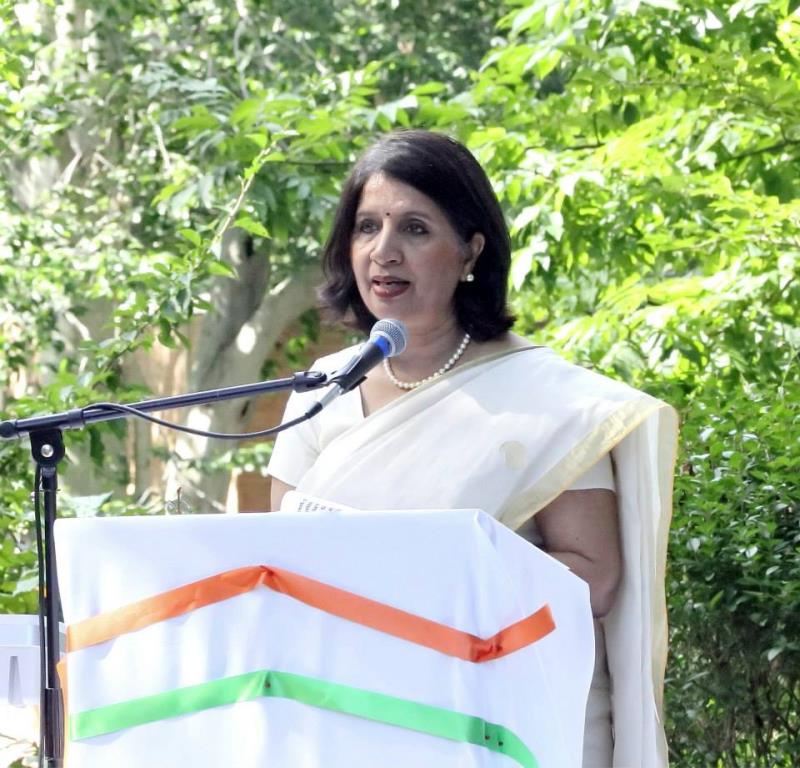May 20, 2014
Freedom fighter, hotelier and entrepreneur… Capt. Nair was more than an extraordinary success story. He was also incredibly warm and undeniably courteous recalls Shonali Muthalaly

Capt C.P. Krishnan Nair, Chairman, Leela Palace, at the interview in 2012.
May 20, 2014
Freedom fighter, hotelier and entrepreneur… Capt. Nair was more than an extraordinary success story. He was also incredibly warm and undeniably courteous recalls Shonali Muthalaly

Capt C.P. Krishnan Nair, Chairman, Leela Palace, at the interview in 2012.
CHENNAI: I wasn’t sure what to expect, to be honest. Freedom fighter, hotelier and entrepreneur Captain C.P. Krishnan Nair’s reputation preceded him. This was the man who revived India’s handloom industry in the 1950s. Who popularized the legendary bleeding Madras fabric, a triumph of marketing, in the ‘60s. And who kicked off a successful, and flamboyant, career as a hotelier at the age of 65.
Waiting to meet Capt. Nair in the lobby of the glittering Leela Palace in 2012, I conjured up an image of someone slick, quick-talking and ruthlessly efficient. Chennai’s Leela Palace was ready to be launched. And Capt. Nair had flown in for the occasion. Which made this the perfect time to do a profile on him. Only, the lead up to our meeting was decidedly nerve wracking. Hushed men in glossy suits gathered around me when it was finally time for the interview. We walked through long, gleaming corridors, passing various levels of security, till we reached Capt. Nair’s room. I apprehensively pushed open the door, only to see a sweet, dapper, cheerful 90-year-old man beaming fondly at me. “Give her a cushion,” he directed the entourage. A cushion? “Yes. Lean back. Be comfortable,” he smiled, as I settled on the sofa, amid a pile of quickly arranged cushions.
On Saturday, May 17, Capt. Nair passed away in Mumbai after a brief illness, aged 92. Over the weekend, there was — of course — plenty of press on him and his achievements. After all, he was a remarkable man who lived through, and in many ways influenced, the course of Indian history. But on a personal note, he was also one of the most extraordinary success stories I’ve met, as incredibly warm as he was undeniably sharp. As tough as he was courteous. Meticulous when it came to business, yet happy to take a break for interesting gossip.
His story
Born and raised in Kannur, Kerala, Capt. Nair was one of eight children. His mother was a farmer, and his father a Government official drawing a salary of Rs. 9 a month. Studying in a school funded by the Maharaja of Chirakkal, he met the Maharaja when he was 10 years old and recited an impromptu poem. The raja was so impressed he said, “This boy must be given a scholarship for life.”
Over the next four hours, Capt. Nair slowly and conscientiously led me through his life, tenaciously resisting any attempt I made to move to what I considered the highlights of his career. “Bleeding Madras? The Leela hotels? No. No. That comes much later. First let me tell you about what happened when I was 11 years old.” Resigned, I finally sat back and listened.
It was quite a story. In his early teens, he met Communist leaders A.K. Gopalan and P. Krishna Pillai, who asked him to be secretary of the student movement in Kannur. “I would take 200 boys to agitate — and we would be in the forefront so the authorities couldn’t attack us. We were 12, 13, 14 years old.” By the time he moved to Chennai to study, A.K. Gopalan and the rest had gone underground. “I was staying in Chintadripet. He’d come to my room early in the morning, before sunrise, and go straight to sleep. I’d lock the door from outside and leave to college, so he could rest.”
After Chennai, he moved to Bangalore and ended up joining the Army. In between, he took three weeks off “for spiritual pursuits” and went to Rishikesh in saffron robes. “I met Swami Sivananda there.” (One of the best known Yoga masters of the 20th century, Swami Sivananda, is the inspiration behind the Sivananda Yoga Vedanta Centres, which currently stretch from New York to Tel Aviv.) “I followed him everyday, till he said ‘Don’t pester me’.” True to character, Capt Nair did not give in. “I made him a kutir to meditate: cleaned the area with an axe, swept, arranged leaves on top. It took two days. He finally agreed to move there.” Today that area belongs to the Divine Life Society, his ashram.
The rest is, of course, history. He married Leela, the daughter of a handloom owner from Kannur, and subsequently worked on revolutionizing the Indian textile industry. Then came Bleeding Madras, and the Leela hotels, which he named after his wife.
However, what I remember is how he disappeared mid-way through the four-hour interview, and then quickly re-appeared in a spunky, impeccably tailored pink suit, complete with an extravagantly coloured silk handkerchief, for our photo shoot. How he obligingly posed, excitedly pointing out ideal spots for the shoot, then charging over to each, followed closely by his loyal entourage. And how, after a four-hour interview that began at 4 p.m., he looked hurt when I said I had to leave, and gasped, “But I thought you’ll have dinner with me.”
Then with trademark old world chivalry, he insisted on walking me to the lobby and waited patiently outside, on an especially muggy Chennai evening, for my car to arrive. When it finally did, and I waved goodbye, the entourage closed in one final time — opening the car’s back door and quickly sliding in a chocolate cake, despite my protests. “No. No,” he said firmly, “You may get hungry on the way home.”
Courtesy: The Hindu
















































































































